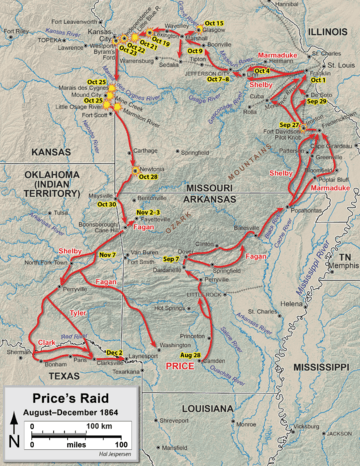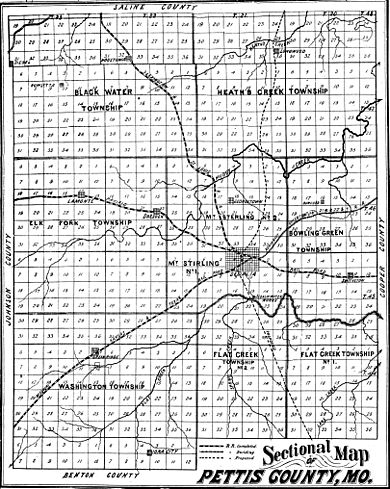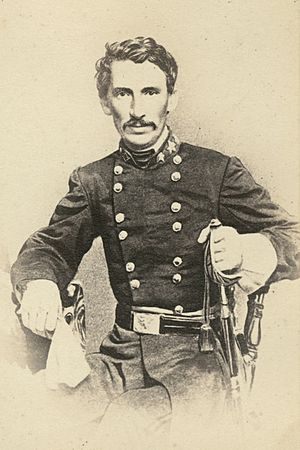Capture of Sedalia facts for kids
Quick facts for kids Capture of Sedalia |
|||||||
|---|---|---|---|---|---|---|---|
| Part of Price's Raid during the American Civil War |
|||||||
|
|||||||
| Belligerents | |||||||
| Commanders and leaders | |||||||
| M. Jeff Thompson | John D. Crawford | ||||||
| Units involved | |||||||
| Shelby's Brigade | Home guards and Enrolled Missouri Militia 7th Missouri State Militia Cavalry |
||||||
| Strength | |||||||
| c. 1,200 men | c. 830 men | ||||||
| Casualties and losses | |||||||
| Unknown | 1 dead and 23 wounded Several hundred captured and released or paroled |
||||||
The capture of Sedalia happened during the American Civil War. On October 15, 1864, a group of Confederate soldiers took over the town of Sedalia, Missouri. They captured the Union soldiers defending it.
Confederate Sterling Price was a former governor of Missouri. He started an invasion into Missouri on August 29, 1864. Price hoped to make the Union army focus on Missouri. He also wanted people in Missouri to rise up against Union control.
Price had to give up his plan to capture St. Louis. This was after a tough fight at the Battle of Fort Davidson. He then moved his army into central Missouri. This area was known as Little Dixie and supported the Confederates.
Many new soldiers joined the Confederates there. Price needed supplies and weapons for them. So, he sent smaller groups to raid towns like Glasgow and Sedalia. One group was about 1,200 men. It was led by M. Jeff Thompson.
Thompson's group attacked Sedalia. The town was mostly defended by local militia (citizen soldiers). The Confederates quickly scattered most of the defenders. Some Union soldiers kept fighting until Thompson brought more of his force. Many militiamen were captured.
After taking supplies and releasing their prisoners, the Confederates left. They went to rejoin Price's main army. Later, on October 23, Price's army was defeated. This happened at the Battle of Westport near Kansas City. The Confederates then retreated. They lost more battles before finally reaching Texas.
Missouri During the Civil War
When the American Civil War began in 1861, Missouri was a state where slavery was allowed. The governor, Claiborne Fox Jackson, supported leaving the United States. He created the pro-secession Missouri State Guard.
Nathaniel Lyon of the Union Army forced Governor Jackson and his supporters out of the state capital, Jefferson City. The Missouri State Guard won some battles. But by the end of 1861, Union forces had pushed them to the southwestern part of the state.
Jackson and his supporters formed a Confederate government of Missouri. This government had to move around a lot. It finally settled in Marshall, Texas. So, Missouri had two different governments at the same time.
The Union gained control of Missouri in March 1862. This was after the Battle of Pea Ridge. For the next two years, Missouri was troubled by guerrilla warfare. This meant small, surprise attacks by unofficial fighters.
Price's Big Plan
By September 1864, things were not going well for the Confederates. The Union army had won battles in the east, like the Atlanta campaign. This helped Abraham Lincoln in the 1864 United States Presidential Election. Lincoln wanted to keep fighting the war.
In the western part of the war, the Confederates had won a battle in Louisiana. But overall, the war was turning against them. A Confederate general named Edmund Kirby Smith was told to send his soldiers to the main fighting areas. But this was impossible because the Union Navy controlled the Mississippi River. This meant large groups of soldiers could not cross.
General Smith decided on a different plan. He would launch an attack to make the Union army move its troops. This would help the Confederates in other parts of the war. Sterling Price and the Confederate Governor of Missouri, Thomas Caute Reynolds, suggested invading Missouri. Smith agreed and put Price in charge.
Price had been a governor of Missouri. He also fought in the Mexican–American War. He believed his campaign would cause people in Missouri to rise up against the Union. Many Union soldiers had left Missouri. So, the state's main defense was the Missouri State Militia. Price also hoped his actions would help George B. McClellan win the election against Lincoln. On September 19, Price's army of about 12,000 to 13,000 men entered Missouri.
Price soon learned that Union soldiers were at Fort Davidson near Pilot Knob. He didn't want a Union force behind his army. So, Price decided to attack the fort. The attack, called the Battle of Fort Davidson, happened on September 27. The Confederates lost many soldiers and were pushed back.
The Union defenders left the fort that night. But Price decided to give up his plan to capture St. Louis. His soldiers had lost at least 800 men. Their spirits were low.
After giving up on St. Louis, Price's army headed for Jefferson City. They moved slowly because they had a large supply train (wagons carrying supplies). On October 7, the Confederates got close to Jefferson City. About 7,000 Union soldiers, mostly inexperienced militia, defended it.
Price thought there were 15,000 Union soldiers. Fearing another defeat like Fort Davidson, he decided not to attack. The next day, he moved his army towards Boonville. Boonville was in the pro-Confederate area of Little Dixie. Price was able to get about 1,200 or 2,500 new soldiers there.
Price needed weapons and supplies. So, he sent two groups away from his main army. John Bullock Clark Jr. was sent to Glasgow. M. Jeff Thompson and his brigade (a large group of soldiers) were sent to Sedalia.
The Battle for Sedalia
Price wanted to capture Sedalia because of a rumor. He heard the Union army had thousands of mules and cattle there. These animals would help feed and provide horses for the Confederate army.
Thompson's group had about 1,200 to 1,500 men. It included Shelby's Iron Brigade. Many of Thompson's soldiers were away visiting their homes. One part of his group, Slayback's battalion, had been scouting. They rejoined Thompson near Longwood. They reported that Union cavalry (soldiers on horseback) were in the area. But they had moved west.
The next day, the Confederates continued their march. They captured two Union soldiers near Georgetown. These prisoners said they were former Confederates forced to join the Union. They told Thompson that Union forces were gathering in Jefferson City and Kansas City. They also said Union foot soldiers were in California. These soldiers were getting ready to go to Georgetown.
Thompson sent a message to Price about this news. Thompson first decided to cancel the attack on Sedalia. But then he changed his mind. He believed the Union foot soldiers were not coming his way. He also thought the Union cavalry was too far away to stop him.
Sedalia was in the middle of a wide-open prairie. There were few trees or places to hide for an attacking army. The town had two small forts (called redoubts) and some rifle pits (trenches for shooting from).
Almost 800 home guard and Enrolled Missouri Militia soldiers defended the town. These were local citizen soldiers. Also, 33 men from the 7th Missouri State Militia Cavalry Regiment were there. They were waiting for a wagon train of ammunition. John D. Crawford commanded the Union soldiers in Sedalia.
Thompson thought surprise was his best chance to win. He attacked before daylight on October 15. The first Confederate soldiers were dressed in captured Union uniforms. They got very close to the Union pickets (guards) before being seen. The Union pickets were scattered and ran back into town.
Crawford and many of his militia soldiers also ran away. One Union officer said Crawford ordered his men to retreat as soon as they saw Thompson's soldiers. But the men of the 7th Missouri State Militia Cavalry held their ground. They formed a line of defense.
The first Confederate group had gotten ahead of the rest. They fell back when they met this unexpected resistance. Within ten minutes, the rest of Thompson's group arrived. This included their artillery (cannons). Confederate cannon fire scattered the remaining militia soldiers. The men of the 7th Missouri State Militia Cavalry then surrendered the town.
Thompson reported that his soldiers didn't know the defenders had fled. This was because the Union flags were still flying over the defenses. Confederate soldiers chased the fleeing militiamen across the prairie. They caused an unknown number of injuries.
What Happened After
After the fighting, some plundering happened. Historian Paul B. Jenkins wrote in 1906 that Thompson's men looted Sedalia. Government property was especially targeted for destruction. Another historian, Paul Kirkman, says Thompson tried to limit the plundering to military supplies.
Modern historian Kyle Sinisi says Thompson tried to keep the taking of military property orderly. But things got out of his control. Sinisi states that the looting mostly happened in businesses, not private homes. Some people saw Confederates riding without shoes. They carried their boots filled with stolen supplies. Sedalia's post office was also plundered.
Thompson claimed that "no outrage or murder was committed." He reported capturing many weapons and wagons of "goods suitable for soldiers." Most of the Confederate groups became disorganized after the battle. Slayback's Battalion was the most organized. They performed guard duty after the fight. Thompson captured almost 2,000 mules and cattle.
The Union army had one soldier killed and 23 wounded. Several hundred Union soldiers were captured. But Thompson could not keep them as prisoners. He also couldn't give them official written paroles (promises not to fight again).
Thompson treated the prisoners differently. A few hundred were local home guard. They were released. But 75 Enrolled Missouri Militia and 47 Missouri State Militia soldiers were given verbal paroles. They were threatened if they broke their promises. Some Union officers said this was against the rules, but they were ignored.
Knowing Union forces could trap them, the Confederates left Sedalia within hours. Thompson moved north to rejoin Price's main army. He met them on October 18.
Clark's raid on Glasgow was also successful. By October 19, the Confederates reached Lexington. They fought a Union force there in the Second Battle of Lexington. Two days later, Union General James G. Blunt tried to stop Price. This happened at the Little Blue River. But Blunt was defeated.
After more fighting, Price met nearly 20,000 Union soldiers. This was near Kansas City on October 23. The Battle of Westport followed. Price's 9,000 soldiers were soundly defeated. Price then retreated into Kansas. But he was defeated again at the Battle of Mine Creek on October 25. About 600 Confederate soldiers were captured there. Later that day, Price ordered almost all of his heavy supply wagons to be destroyed.
The last major battle of the campaign happened on October 28. This was near Newtonia, Missouri. In the Second Battle of Newtonia, Price was defeated by Blunt. By this time, the Confederate army was falling apart. Union troops kept chasing Price. The Confederates finally reached the Arkansas River on November 8. They kept retreating until they reached Texas by the end of November 1864.
The campaign did not affect the election. And while some Union troops were sent to Missouri, it was only for a short time. It did not greatly impact other battles in the war.




